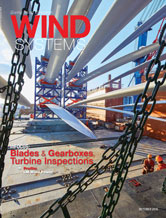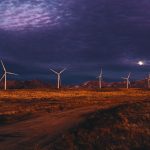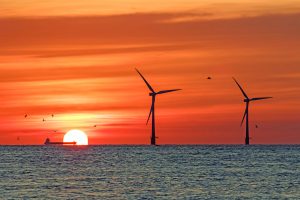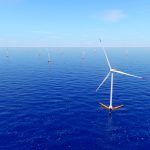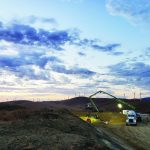In the wind industry, complex organo-metallic gear-oil chemistry and its resulting higher water content have sometimes been blamed for gearbox damage or failure. But water in oil is not the cause of gearbox failure. Rather, the characteristics of wind-turbine operations and the resulting transient loads are the root cause of nearly all failures.
Transient loads are the underlying cause of gearbox failure. Common characteristics of organo-metallic oil formulation — those typically using molybdenum-based EP additives — have met with some criticism, but it does not lead to these costly failures. Despite some currently held industry theory, it is inaccurate to attribute gearbox failure to organo-metallic gearbox oil that is able to hold a higher amount of water.
The Challenges of Wind Equipment
Wind-equipment conditions are different than those in any other industrial gearing application.
A wind turbine’s substantial load of overhanging weight — combined with varied climate and geographical conditions and consistently unpredictable weather extremes — presents a series of challenges seen only in the wind industry.
In fact, sheer weight has an exponential impact on equipment. For example: A turbine’s blades and hub weigh 30 tons — which is supported by one bearing and gearbox with a three-foot generator on the other end — and it’s all held 300 feet in the air by a solid-steel shaft two feet in diameter.
The resulting effects of unpredictable conditions can be extraordinary.

Transient Events
When a wind turbine experiences a transient event — a short-lived burst of energy caused by a sudden change of state — it can be a violent occurrence.
Gears and bearings are designed around specifications for normal operating conditions.
In other industries, normal operating conditions are easy to predict. But with a wind turbine, it is impossible to measure transient loads.
 A wind turbine is not, by nature, designed to handle these events. What’s more, many of these transient events happen hundreds of times a day — for example, with a gust of wind or change of wind direction. As a result, while wind turbines are designed for normal operating conditions, there is no way to anticipate what transient loads might be seen.
A wind turbine is not, by nature, designed to handle these events. What’s more, many of these transient events happen hundreds of times a day — for example, with a gust of wind or change of wind direction. As a result, while wind turbines are designed for normal operating conditions, there is no way to anticipate what transient loads might be seen.
I employ the American Gear Manufacturers Association’s safety factor to determine normal operating conditions. But while this evaluation applies to typical industrial gearing, this is not the case in wind. The standard safety factor for wind turbines is 30 percent (which falls in between AGMA light and medium duty). Anyone in the industry will say a wind turbine is a heavy-duty application.
Building equipment based on normal operating conditions will satisfy 95 percent of concerns. But the remaining 5 percent is what separates the art from the science.
There are ways to monitor the progression of failure in a live machine in order to prevent that failure. Examples of “condition monitoring” tactics include measuring temperature, cleanliness of oil, vibrations the bearings and gear meshes create as they rotate, power output, and power consumption.
But in my experience in monitoring gearbox failure in general and wind-turbine gearbox failure in particular, all of these variable factors should be considered “symptoms.” In fact, transient loads are the cause of the actual failure.
Stopping Protocols
In my current role, I measure the effects of stopping protocols, and I have found stopping protocols result in more than triple a wind turbine’s normal torque, but in the opposite direction. And in some turbines, stopping protocols (which include emergency stops/E-stops) can happen 200 to 300 times a year.
Power Grid Failure
When grid failure occurs, resistance is gone almost instantly. The system can now unwind in the opposite direction of what it is used to, causing torque reversals and “wreaking havoc.”
You can have the best gears, bearings, and oil on the planet. You can have diligent ongoing live equipment monitoring. You can work on either side of the design equation, experimenting with handling more load or less load. You can try building with different steel and alter other fabrication elements. But at the end of the day, none of these variables has anywhere near the impact on gearbox failure than the loads themselves.
Does Gear Oil Cause Gearbox Failure?
As anyone in the wind industry knows, when a gearbox fails, it can be a costly occurrence. It also can lead to the inevitable desire to get to the root of the problem and look to assign blame.
Most turbines that fail are still using their original gear oil fill — so it’s not uncommon for managers to group the original oil in with the original equipment when discussing gearbox failure.
But in the wind industry, there are few, if any, lube-related failures.
These OEM first-fill gear oils fall victim to this incorrect theory primarily because of their association with the original equipment. There are certain gear-oil formulations that, even though they offer long-lasting protection for costly machinery, have certain attributes or results that have been called into question on occasion.
But these qualities or visual characteristics do not affect gearbox failure.
 Water in Oil
Water in Oil
A common discussion in the wind industry relates to high-water content in gearbox oil. Overall, the impact of water content in synthetic gearbox oil is dependent upon whether the water content is near the saturation limit and if the water is fully dissolved in the oil.
Certain organo-metallic oil chemistry results in an affinity to water that enables the oil to handle up to five times as much water as some ashless and sulfur/phosphorous-based gear oils. If the oil is formulated to hold a high level of water, then water in that oil is simply not an issue.
Most oils (e.g., ashless) can’t capture more than 300 parts per million (PPM) without failing. So, if that oil tests at 150 PPM, it could be a cause for concern, as that water can escape solution, interfere with gears and bearings, and cause corrosion.
Water and the Additive Package
Organo-metallic gear oils are engineered to protect and maximize the performance of wind-turbine gwearboxes. Some characteristics of organo-metallic oil with the ability to hold higher levels of water display visible signs. But these conditions do not affect gearbox failure.
Some of these signs include:
Sludge: Due to the complex additive package in these oils, water can react with some of the additives and “fall out of solution.” The resulting out-of-solution additives are referred to as sludge. Sludge can collect in the low-flow area of a gearbox and cause staining. But while this may make looking at gearbox damage more difficult, the sludge itself does not cause damage or failure.
Foaming and Micro-pitting: The other condition that can arise from gear oil with a high water content is foaming, caused as the oil churns up and captures air. Foam can sometimes cause a small amount of near-surface micro-pitting — but we are not seeing that it causes any failures, unless foam has replaced oil. In wind equipment, the micro-pitting is more likely attributed to transient loads.
Investigating Transient Events
Over the past 12 years, I have inspected a lot of turbines. Nearly all failures are caused by transient loads (which are also peak loads, versus loads under normal operating conditions) — and they happen much more frequently than people suspect.
Specific failures include those attributed to gears and bearings.
Gear Failure: The two leading causes of gear failure are soft metal inclusions and grind temper damage in gear teeth. Interestingly, both of these phenomena exist in 95 percent of the world’s gears, but the equipment in other industries typically continues to run no signs of these conditions, and they don’t cause damage or failures. But in the wind industry, one peak load can expose these defects.
Bearing Failure: The two most common causes of bearing failures are axial cracks (also called white-etch cracks, so called when the bearing surface and sub-surface fatigue failures are characterized by white edges along the cracks) in roller bearings and spalling in tapered roller bearings. Both of these failure modes are caused by “hard spots” in the steel structure of the bearing. But they manifest differently.

These hard spots deep within the steel structure are known as adiabatic shear bands. In the case of wind-equipment roller bearings, the origins of shear bands can be attributed to peak transient loads. And they are the root cause of the axial cracks and spalling that are, in essence, crack-initiation points.
Hydrogen Embrittlement: Hydrogen embrittlement occurs when metals such as steel become brittle and fracture due to the introduction and subsequent diffusion of hydrogen into the metal. When white-etch cracking was first discovered in wind-turbine bearings, the bearing manufacturer attributed the problem to hydrogen embrittlement and blamed the gear oil. The theory was that if too much water was entrained in gear oil, the steel attracted hydrogen out of the water when heat and pressure were introduced, resulting in hydrogen embrittlement.
I dispute this theory. White-etch cracking/hydrogen embrittlement can’t happen unless there is already a crack or inclusion brought on by transient loads. In fact, I hypothesize hydrogen embrittlement may not even factor into the problem at all if adiabatic shear bands already exist.
Given the factors that are unique to the relatively young wind industry and my extensive examinations of wind turbines and their gearboxes for more than a decade, I concluded that, despite some industry theories, the presence of water in gear oil that is formulated to hold a high level of water is not an issue. In fact, water in these oils cannot be linked to gearbox failure.
Unless the oil being used is not correct for the application — for example, mineral oil being used in an extremely cold climate — the best solution is to stay with a wind turbine’s original oil fill product to avoid potential problems.
In Summary
Through my lengthy tenure and hands-on experience in the wind industry, I confirm water content in gear oil is not the cause of gearbox failure.
Rather, gear-and-bearing failure can be attributed to the transient events that occur hundreds of times per year — the effects of which can never be predicted in equipment that has been designed for normal operating conditions.
You can have the best gears, bearings, and oil on the planet. You can have diligent ongoing live equipment monitoring. But it’s the transient events that have everything to do with wind-turbine failure.
For More Information
Castrol has more than 30 years of experience supporting the wind-energy industry, supplying lubricants to thousands of wind turbines and providing global product support services. In addition, BP, Castrol’s parent company, is one of the largest wind-park owners in the United States, with a gross generating capacity of approximately 2,600 MW, which equates to electricity to power more than 775,000 average American homes.
Castrol’s global reach provides access to a worldwide network of sales, engineering, research, and manufacturing capabilities to support wind-farm operations and maintenance needs. A network of specialist service companies also supports oil-change procedures in line with the requirements of wind-turbine OEMs. For more information, go to www.castrol.com/windenergy.
















